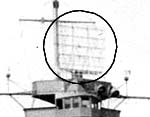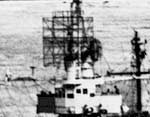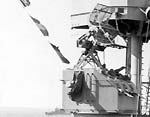·猪钢鬃·
摘抄学习军政知识
正文
简介:
企业号(Enterprise CV-6)是第7艘以企业命名的舰只,她是约克城级航母中的第2艘,于1934年7月动工建造,1936年10月下水,1938年5月在东海岸开始服役,1939年4月转入太平洋服役。
企业号绰号“大企(the Big E)”,几乎参加了太平洋的所有重要战役。大企是个幸运儿,在对手是崇尚武士道的日本人的情况下,能够看到战争的结束本身就说明了这一点。
企业号在二战中共获20枚战役之星勋章,她于1947年退出现役。第8艘以企业号命名的舰只就是1959年的第一艘核动力航母,企业号的战斗精神与其名字一样将一直延续下去。
美国“企业”(Enterprise CVN-65)号核动力航空母舰为世界上第一艘核动力航空母舰。1964年,“企业”号进行了史无前例的环球航行,途中无需加油和再补给,历时64天,总航程3万多海里,充分显示了核动力的巨大续航力。
The Most Decorated Ship of the Second World War
二次大战中最辉煌的战舰
Source: United States Naval Institute
来源:美国海军研究协会
"The carrier that fought the most through the entire war..."
-----Dedicatory Plaque, Enterprise Tower, U.S. Naval Academy
“这艘航母几乎参加了战争中的全部战役”
-----奉献铭记,企业号舰塔,美国海军学院
Enterprise entered World War II on the morning of December 7, 1941, when her scout planes encountered the Japanese squadrons attacking Pearl Harbor. Not until May 14, 1945, when a Kamikaze attack off Kyushu, Japan, left a gaping hole in her flight deck, was she forced to leave the war.
Of the more than twenty major actions of the Pacific War, Enterprise engaged in all but two. Her planes and guns downed 911 enemy planes; her bombers sank 71 ships, and damaged or destroyed 192 more. Her presence inspired both pride and fear: pride in her still unmatched combat record, and fear in the knowledge that Enterprise and hard fighting were never far apart.
The most decorated ship of the Second World War, Enterprise changed the very course of a war she seemed to have been expressly created for.
1941年12月7日早上当企业号的侦察机发现日军飞机偷袭珍珠港时,她开始真正进入二战。直到1945年5月14日,一架从日本九州起飞的自杀轰炸机在她的甲板上炸开一个大洞后,她才被迫退出战争。
太平洋战争的二十几次重大战斗,“企业”号只错过了其中的两次。她的飞机和舰炮击落了911架敌机;她的炸弹击沉了71艘敌舰,击伤超过敌舰超过192艘。她的传奇是骄傲而又恐怖的。骄傲是因为她无人可及的作战纪录,恐怖是因为她的残酷战斗从未间断过。
“企业”号,这艘二战中最辉煌的战舰,改变了这场战争的进程。
原文来源链接:http://www.cv6.org/
企业号(Enterprise CV-6)是第7艘以企业命名的舰只,她是约克城级航母中的第2艘,于1934年7月动工建造,1936年10月下水,1938年5月在东海岸开始服役,1939年4月转入太平洋服役。
企业号绰号“大企(the Big E)”,几乎参加了太平洋的所有重要战役。大企是个幸运儿,在对手是崇尚武士道的日本人的情况下,能够看到战争的结束本身就说明了这一点。
企业号在二战中共获20枚战役之星勋章,她于1947年退出现役。第8艘以企业号命名的舰只就是1959年的第一艘核动力航母,企业号的战斗精神与其名字一样将一直延续下去。
美国“企业”(Enterprise CVN-65)号核动力航空母舰为世界上第一艘核动力航空母舰。1964年,“企业”号进行了史无前例的环球航行,途中无需加油和再补给,历时64天,总航程3万多海里,充分显示了核动力的巨大续航力。
The Most Decorated Ship of the Second World War
二次大战中最辉煌的战舰
Source: United States Naval Institute
来源:美国海军研究协会
"The carrier that fought the most through the entire war..."
-----Dedicatory Plaque, Enterprise Tower, U.S. Naval Academy
“这艘航母几乎参加了战争中的全部战役”
-----奉献铭记,企业号舰塔,美国海军学院
Enterprise entered World War II on the morning of December 7, 1941, when her scout planes encountered the Japanese squadrons attacking Pearl Harbor. Not until May 14, 1945, when a Kamikaze attack off Kyushu, Japan, left a gaping hole in her flight deck, was she forced to leave the war.
Of the more than twenty major actions of the Pacific War, Enterprise engaged in all but two. Her planes and guns downed 911 enemy planes; her bombers sank 71 ships, and damaged or destroyed 192 more. Her presence inspired both pride and fear: pride in her still unmatched combat record, and fear in the knowledge that Enterprise and hard fighting were never far apart.
The most decorated ship of the Second World War, Enterprise changed the very course of a war she seemed to have been expressly created for.
1941年12月7日早上当企业号的侦察机发现日军飞机偷袭珍珠港时,她开始真正进入二战。直到1945年5月14日,一架从日本九州起飞的自杀轰炸机在她的甲板上炸开一个大洞后,她才被迫退出战争。
太平洋战争的二十几次重大战斗,“企业”号只错过了其中的两次。她的飞机和舰炮击落了911架敌机;她的炸弹击沉了71艘敌舰,击伤超过敌舰超过192艘。她的传奇是骄傲而又恐怖的。骄傲是因为她无人可及的作战纪录,恐怖是因为她的残酷战斗从未间断过。
“企业”号,这艘二战中最辉煌的战舰,改变了这场战争的进程。
| ||||
| ||||
| ||||
| ||||
| ||||
| ||||
| ||||
| ||||
| ||||
原文来源链接:http://www.cv6.org/
评论
目前还没有任何评论
登录后才可评论.

























